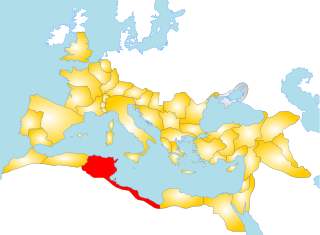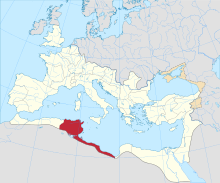Parthenia was a Roman–Berber town in the former Roman province of Mauretania Sitifensis, the easternmost part of ancient Mauretania. It was located in what is now northern Algeria.

Haïdra is a municipality in western Tunisia, containing the ruins of Ammaedara, one of the oldest Roman cities in Africa. It was a diocese and is now a Roman Catholic titular see.
Boumedfaa a town in northern Algeria.

Khemis Miliana is a town in northern Algeria of around 500000 inhabitants. It is a university town located 120 kilometers west of Algiers. It was known as Malliana in Roman times, then Affreville during the French colonial era. It should not be confused with the smaller city of Miliana nearby.

Tiddis was a Roman city that depended on Cirta and a bishopric as "Tiddi", which remains a Latin Catholic titular see.

Girus Tarasii was a town in the Roman province of Numidia that became a residential episcopal see. It is tentatively identified with ruins situated at what is now called Henchir-Tarsa in Algeria.

Decoriana was an ancient Roman–Berber city and former bishopric in Tunisia. It is now a Latin Catholic titular see.

Absa Salla was a Roman and Byzantine-era town in the Roman province of Africa proconsularis. It was also the seat of a titular see of the Roman Catholic Church. with the same name. The location of the town remains unknown but is known to have existed for certain between 300 and 650AD.

Lamzella was a civitas (town) in the Roman–Berber province of Numidia. It has been tentatively identified with the ruins at Henchir-Resdis in modern Algeria.
Cenculiana was a Roman era town in Roman North Africa.
Drusiliana was a civitas (town) of Roman North Africa. Bingham called it a city of the Roman province of Mauretania Caesariensis. An inscription of Constantine the Great was found in the city ruins and it appears on the Tabula Peutingeriana The town has been tentatively identified with ruins near Khanguet-el-Kdim in northern Algeria. Located at 36.249547°N 8.907667°E. Epigraphical evidence suggest Constantine the Great undertook some works in the city in 312AD.

Cubda was an ancient city in Tunisia. It is a titular bishopric of the Roman Catholic Church.

Douela or Douala is a village and locality in Tunisia, situated on the Mediterranean coast at latitude 36.8167°, longitude 10.5667° and near Sīdī `Ammār, Korbous, and El Bredj.

Utimma was an ancient city in the Roman province of Africa Proconsularis during the Byzantine and Roman Empires. the exact location of Utimma is lost to history but it is believed to be between Sidi Medien and Henchir-Reoucha in Tunisia.

Melzi was a civitas (town) of the Roman Empire during late antiquity. It was also known as Meditanus.
Henchir-Baldia is an archaeological site and locality in southern Tunisia. The stone ruins are tentatively associated with Bladia, a civitas of the Roman province of Byzacena during the Roman Empire. It was a Catholic bishopric.
Gunugus or Gunugu was a Berber and Carthaginian town in northwest Africa in antiquity. It passed into Roman control during the Punic Wars and was the site of a colony of veteran soldiers. It survived the Vandals and Byzantines but was destroyed during the Muslim invasion of the area.
Rusubbicari was a Phoenician and Carthaginian colony and Roman town. It has been tentatively identified with ruins at Zemmouri El Bahri, Algeria. The Roman town was in the province of Mauretania Caesariensis.

Tamada was an ancient Roman–Berber civitas in the province of Mauretania Caesariensis. The town lasted through the Byzantine Empire, Vandal Kingdom and Roman Empire into late antiquity, until at least the Muslim conquest of the Maghreb in the 7th century.

Temuniana was a Roman town of Roman North Africa which existed during the Vandal Kingdom, Byzantine Empire and Roman Empire.









